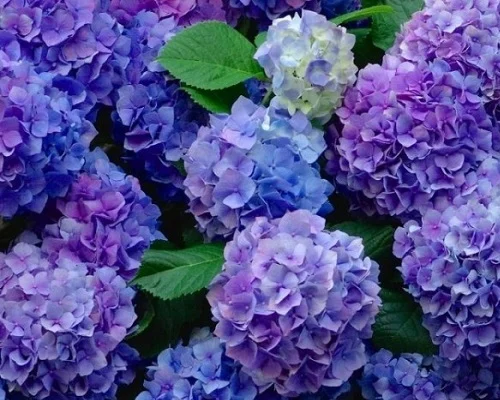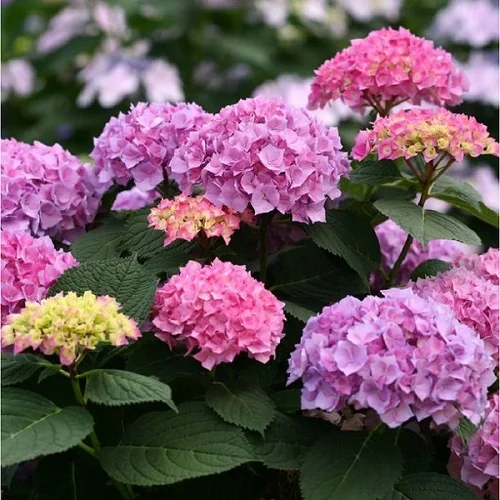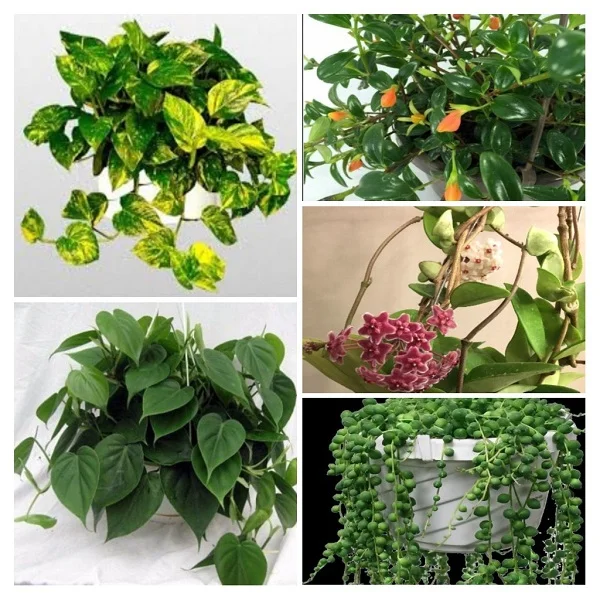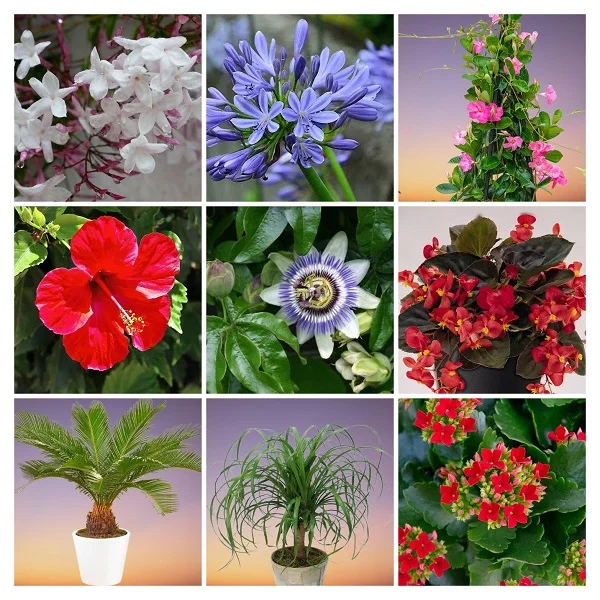Bigleaf Hydrangea (Hydrangea macrophylla) Care Indoors, Propagation and Growing Problems
Some links in this post may be affiliate links
Bigleaf Hydrangea (Hydrangea macrophylla) flourishes in bright light, cool temperatures, average humidity and consistently moist, rich, well-drained, all purpose soils coupled with fortnightly feeding in the growing season.
Hydrangea macrophylla also called Mophead Hydrangea, French Hydrangea, Hortensia or Lacecap Hydrangea is among the popular flowering plants whose blooms can be white, blue, red, pink, light purple or dark purple where the color is affected by the soil PH.
A PH below 7 (acidic soil) will produce a flower color closer to blue while a PH above 7 (alkaline soil) will produce flowers that are more pink. However, only the pink varieties of Bigleaf Hydrangea can be blued.
The species name, 'macrophylla' is in reference to the large, oval, saw-edged leaves which are about 4-6 inches long.

Botanical name: Hydrangea macrophylla
Family: Hydrangeaceae
Common names: Bigleaf Hydrangea, Mophead Hydrangea, French Hydrangea, Hortensia, Lacecap Hydrangea
Origin
Hydrangea macrophylla is native to the seaside habitats as well as mountains in Japan, from Honshu southwards.
Size
Bigleaf Hydrangea is a perennial shrub growing to 7 feet tall by 8 feet broad and bears large globular heads of flowers about 6-8 in. across.
Toxicity
All parts of Hydrangea macrophylla is toxic to both humans and pets as indicated by ASPCA. If ingested it can cause nausea, diarrhea and vomiting. It produces a sap which can cause dermatitis in sensitive skin. Always wear gloves when handling it and keep it out of the reach of children and pets to avoid accidental consumption.
Where to Buy
Would you like to add Bigleaf Hydrangea to your collection? You may acquire them from Etsy (Link to Etsy).
Hydrangea macrophylla Care Indoors
Bigleaf Hydrangea (Hydrangea macrophylla) blooms in bright light away from direct sunlight, cool temperatures of 10-180C, average humidity of 50-55% and consistently moist, fertile, well-drained, all purpose soils coupled with fortnightly feeding during the growing season.
Hydrangea macrophylla requires regular pruning to keep it neat as well as control control growth to keep it compact. It needs annual repotting after flowering is over for a lush growth. Continue reading for more on these growing conditions and how to provide them.

Watering
Water Bigleaf Hydrangea thoroughly during the growing season and allow the top 1-2 inches of soil to dry out between waterings to maintain the soil moist at all times.
Cut down on watering in the cold period to keep the soil slightly moist as growth is minimal at this time but do not let the soil dry out completely.
Confirm that the pot has a drainage hole to avoid getting soggy soil as it can result in root-rot and death of the plant. Avoid wetting the blooms as it can lead to rotting. Water from the bottom instead.
Light Requirements
Bigleaf Hydrangea grows best under bright light; a spot infront of a large brightly-lit window is perfect for this plant. Keep it away from direct sunlight.
If light is not adequate, it will grow slowly and will not bloom. Where the natural lighting is not adequate instal grow lights to supplement it. Take a look at these full spectrum grow lights on Amazon.
Turn the pot regularly to ensure the plant receives light on all sides for even growth and prevent leggy growth.
Temperature and Humidity
Mophead Hydrangea thrives in cool temperature of 10-180C. The cool temperatures prolong the flowering period. Keep it away from drafts as they cn cause reduced growth and blooming.
Average room humidity of 50-55% is ideal for Bigleaf Hydrangea Plant though it benefits from high humidity. To elevate humidity, set the pot on a wet pebble tray or use a cool mist humidifier. Check out these techniques on how to raise humidity for houseplants.
Potting Mix
The best potting mix for Bigleaf Hydrangea should be rich in organic matter and free-draining to prevent it from getting soggy while providing the required nutrients. All purpose potting mixes are ideal for this plant.
Fertilizer
Feed French Hydrangea with a phosphorous-rich, water-soluble fertilizer every 2-3 weeks during the growing season. Withhold feeding in the cold season as growth is minimal.
Pruning
Prune Bigleaf Hydrangea by removing dead blooms and leaves to maintain the plant neat and tidy. The blooms can also be cut and preserved in a vase as dry flowers.
Repot Lacecap Hydrangea and cutback the stems to half their height after flowering is over to encourage new growth and prevent the plant from becoming too large. Place it in a cool place and reduce watering and continue feeding.
Repotting
Repot Hortensia during the growing season when flowering is over. To keep it small, cutback the stems to half their height and continue to water and feed. This will encourage a lush growth.
Use a pot only one size larger than the current one to avoid overpotting. Ensure the pot has a drainage hole and the soil is free-draining to prevent the soil from getting soggy as it can lead to root-rot. Check out these pots with drainage holes on Amazon.
Propagation
Bigleaf Hydrangea (Hydrangea macrophylla) can be propagated at the beginning of the growing season from stem cuttings.
How to propagate Bigleaf Hydrangea from stem cuttings
Take stem cuttings of about 4-6 inches from a healthy Bigleaf Hydrangea and ensure each cutting has at least 2 nodes.
Dip the lower cut end cuttings in a rooting hormone to hasten rooting.
Insert the cutting in moist free-draining soil and cover the set up with clear polythene to create a greenhouse effect in order to promote rooting.
Place the set up in a warm, brightly lit spot away from direct sunlight to avoid sunburn.
Allow the new Mophead Hydrangea plants to be well established before transplanting after which routine care can begin.

Hydrangea macrophylla Problems
Bigleaf Hydrangea (Hydrangea macrophylla) problems include leaf drop, yellowing, lack of blooms, pests and diseases among others which are caused by improper care. Continue reading, herebelow is a detailed account on these problems and how to fix them.
Pests
Common pests in Bigleaf Hydrangea are spider mites and aphids which are more likely to attack in hot and dry conditions (low humidity). To raise air humidity and discourage pest infestation, set the pot on a wet pebble tray or use a cool mist humidifier.
Yellowing and dropping leaves
Bigleaf Hydrangea yellowing and dropping leaves are due to underwatering. Water the plant thoroughly during the growing season and maintain the soil moist at all times. Decrease watering during the cold season to maintain the soil slightly moist and never allow the soil to dry out completely. Learn more on how to water indoor plants the correct way.
No blooms
Bigleaf Hydrangea not blooming (flowering) is due to two possible reasons. One possible reason is too little light. Move the plant to a brighter spot where it will receive bright light or instal a grow light if the natural lighting is inadequate. Check out this guide on understanding light for houseplants.
The second possible reason for French Hydrangea not blooming (flowering) is feeding it with a nitrogen-rich fertilizer which promotes foliage growth at the expense of flowers. Feed the plant with a phosphorous-rich, water-soluble fertilizer every 2-3 weeks during the growing season but do not feed in the cold season.
You liked it? Share on social media.
Related Content
Amazon Associates Disclosure
Homeplantsguide.com is a participant in the Amazon Services LLC Associates Program, an affiliate advertising program designed to provide a means for sites to earn advertising fees by advertising and linking to amazon.com.





